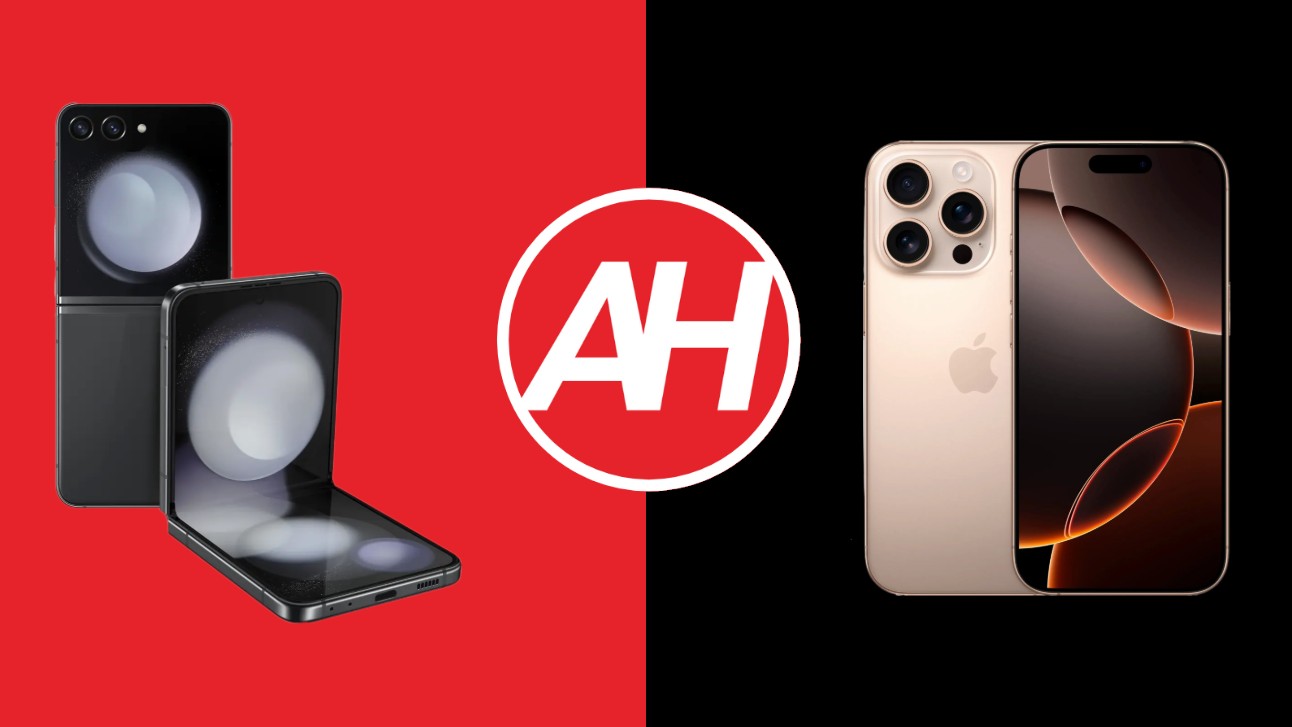Copyright Android Headlines

This time around, we’re comparing Samsung’s best “clamshell-like” phone with Apple’s compact “Pro” flagship phone from last year. We’re talking about the Samsung Galaxy Z Flip 7 and the Apple iPhone 16 Pro. It’s especially interesting to compare these devices considering their extremely different form factors. Here, you’ll find what both devices offer in multiple sections. As usual, we’ll start with the raw tech specs for each device. Then, we’ll compare what each phone offers in key areas that really matter to you, such as design, display, performance, battery life, cameras, and audio output. Without further ado, you’ll find the comparison between both handsets below. Specs Samsung Galaxy Z Flip 7 Apple iPhone 16 Pro Samsung Galaxy Z Flip 7 Apple iPhone 16 Pro Dimensions (unfolded/folded) 166.7 x 75.2 x 6.5 mm / 85.5 x 75.2 x 13.7 mm 149.6 x 71.5 x 8.3 mm Weight 188 grams 199 grams Main display 6.9-inch Foldable Dynamic LTPO AMOLED 2X (120Hz) 6.3-inch LTPO Super Retina XDR OLED (1-120Hz) Cover display 4.1-inch Super AMOLED (120Hz) N/A Resolution 2520 x 1080 / 1048 x 948 1206 x 2622 Chipset Samsung Exynos 2500 Apple A18 Pro RAM 12GB (LPDDR5X) 8GB Storage 256GB/512GB (UFS 4.0) 128GB/256GB/512GB/1TB (NVMe) Main camera 50MP (f/1.8 aperture, 1/1.57-inch sensor size, dual pixel PDAF, OIS) 48MP (f/1.8 aperture, 1/1.28-inch sensor size, 1.22um pixel size, dual pixel PDAF, sensor-shift OIS) Ultra-wide camera 12MP (f/2.2 aperture, 1/3.2-inch sensor size, 123-degree FoV) 48MP (f/2.2 aperture, 1/2.55-inch sensor size, 120-degree FoV, 1.4um pixel size, dual pixel PDAF) Telephoto camera N/A N/A Periscope telephoto camera N/A 12MP (f/2.8 aperture, 1/3.06-inch sensor size, 1.12um pixel size, dual pixel PDAF, 5x optical zoom) Selfie camera 10MP (f/2.2 aperture, 1/3.0-inch sensor size, 1.22um pixel size) 12MP (f/1.9 aperture, 1/3.6-inch sensor size, PDAF, OIS) Battery size 4,300mAh 3,582mAh Charging 25W wired, 15W wireless, 4.5W reverse wireless (charger not included) 25W wired, 15W wireless (MagSafe & Qi2), 7.5W wireless (Qi), 4.5W reverse wired (charger not included) Colors Blue Shadow, Jet Black, Coral Red Black Titanium, White Titanium, Natural Titanium, Desert Titanium Samsung Galaxy Z Flip 7 vs Apple iPhone 16 Pro: Design Let’s dive into the hardware. The Samsung Galaxy Z Flip 7 wraps itself in a combination of aluminum and glass, creating a sleek profile. Its competitor, the iPhone 16 Pro (Review) goes premium with a mix of durable titanium and glass. Both phones maintain that modern, minimalist look with smooth, rounded corners, yet their main surfaces—including the frame, front, and back—stay mostly flat. Up front, the Z Flip 7’s main folding screen features a small, centered hole-punch cutout for the camera. The iPhone 16 Pro, however, opts for a signature pill-shaped cutout. While both displays boast impressively thin borders, the difference is noticeable: Apple’s handset manages to trim the bezels down just a tiny bit more. When it comes to buttons, each phone has its own approach. The Galaxy Z Flip 7 keeps everything tidy on the right side. You’ll find the power/lock and volume keys all stacked there, with the power button pulling double duty as the fast, integrated fingerprint scanner. The iPhone 16 Pro takes a split approach: the power/lock key sits solo on the right, while the left side is home to the volume controls, topped by the handy, customizable Action Key. Flip these devices over, and the differences jump out immediately. The Galaxy Z Flip 7 makes a big statement with a huge second display covering the entire top half of the back. Two horizontally aligned cameras are neatly tucked into the corner of this cover screen. The iPhone 16 Pro skips the second screen entirely, featuring a trio of cameras set into Apple’s familiar raised, square camera island in the top-left corner. Finally, the form factors diverge significantly. When unfolded, the Galaxy Z Flip 7 is noticeably taller, though it maintains a narrower and thinner profile than its rival. It also delivers an advantage in weight: tipping the scales at just 188 grams, the Samsung foldable is lighter than the iPhone 16 Pro’s hefty 199 grams. For protection, the Galaxy Z Flip 7 has IP48 rating for dust and water resistance. Meanwhile, the iPhone 16 Pro boasts superior IP68 certification. Despite their distinct builds, both of these premium phones are quite slippery. Samsung Galaxy Z Flip 7 vs Apple iPhone 16 Pro: Display When you unfold it, the Galaxy Z Flip 7 offers a much bigger main display that stretches to 6.9 inches. This panel is a Foldable Dynamic LTPO AMOLED 2X. It features a super-smooth 120Hz adaptive refresh rate and handles HDR10+ content beautifully, hitting a high peak brightness of 2,600 nits. The phone utilizes its space well with about an 88% screen-to-body ratio, displaying content at a sharp 2520 x 1080 resolution with a tall 21:9 aspect ratio. But wait, there’s more: the phone’s cover display measures 4.1 inches. It’s a Super AMOLED unit with a 120Hz refresh rate (not adaptive), matching the main screen’s 2,600 nits peak brightness. This secondary screen uses a 1048 x 948 resolution and has a robust Gorilla Glass Victus 2 as protection. The iPhone 16 Pro, on the other hand, sports a slightly smaller 6.3-inch main screen. This LTPO Super Retina XDR OLED panel also boasts an adaptive refresh rate up to 120Hz. Apple ensures great media quality by supporting both HDR10 and Dolby Vision standards. While still very bright, its peak brightness level sits at 2,000 nits, a bit lower than its rival. The screen-to-body ratio is excellent at around 89%, and it displays content using a 1206 x 2622 resolution. The iPhone 16 Pro uses a slightly different 19.5:9 aspect ratio and protects its display with Apple’s durable Ceramic Shield glass. When it comes to the viewing experience, these devices are top-tier performers. All three screens—the Flip’s main, its cover, and the iPhone 16 Pro’s panel—are remarkably vivid, incredibly sharp, and offer excellent viewing angles. Touch responsiveness is snappy across the board, too. Crucially, all displays get bright enough for outdoor use, and their high refresh rates ensure navigation and motion are silky smooth. Even the crease on the Galaxy Z Flip 7’s foldable panel is much less noticeable than in earlier generations. Samsung Galaxy Z Flip 7 vs Apple iPhone 16 Pro: Performance Under the hood, the Galaxy Z Flip 7 is driven by Samsung’s proprietary Exynos 2500 processor. This chip is built on a cutting-edge 3nm process and is complemented by a generous 12GB of LPDDR5X RAM. For storage, Samsung utilizes UFS 4.0 flash technology. Meanwhile, the iPhone 16 Pro runs on the formidable Apple A18 Pro chip, which also benefits from 3nm architecture. This processor works alongside 8GB of RAM and swift NVMe flash storage. It’s worth noting that regardless of which phone you choose, neither model offers expandable storage options. In practical use, both of these flagships deliver power that is more than sufficient for almost any task—including the most demanding ones. The Exynos 2500 is undeniably a powerhouse. While it might trail slightly behind a handful of rivals, it represents a strong offering from Samsung. The Apple A18 Pro, conversely, easily stands its ground and boasts an exceptionally capable GPU. When handling daily activities—from multitasking to social media—both phones are absolute champions, executing tasks smoothly without a hint of lag or slowdown. This consistent performance extends seamlessly to mobile gaming. Both devices can handle heavy graphical loads without serious issues, although they will certainly generate heat when pushed to their limits. Importantly, this thermal buildup does not significantly impact their processing power. Neither phone reaches problematic overheating levels, consistently delivering reliable performance even when running the most graphically intensive games currently available on the market. Samsung Galaxy Z Flip 7 vs Apple iPhone 16 Pro: Battery Inside the Galaxy Z Flip 7, you’ll find a 4,300mAh battery. This contrasts sharply with the iPhone 16 Pro, which houses a smaller 3,582mAh cell. This size difference isn’t surprising, as Apple typically relies on hardware and software optimization rather than sheer capacity. To be fair, the Z Flip 7’s battery size is still on the modest side compared to many conventional Android flagships. After all, Samsung’s strategy is to prioritize a thin, lightweight design over the absolute largest battery possible. So, how does battery life translate in the real world? The Galaxy Z Flip 7 actually provides decent endurance, performing better than expected. However, it still doesn’t quite measure up to the stamina of the iPhone 16 Pro. External comparisons suggest Apple’s device can deliver roughly 18% more total battery life. This difference means more screen-on time for the iPhone, although both phones are on par when comparing video playback time. When it’s time to recharge, both devices offer very similar wired speeds. The Galaxy Z Flip 7 supports 25W wired charging, along with 15W wireless and 4.5W reverse wireless charging. The iPhone 16 Pro also handles up to 25W wired charging, supplemented by 15W MagSafe and Qi2 wireless, 7.5W standard Qi, and 4.5W reverse wired charging. Charging times are nearly identical: the Galaxy Z Flip 7 takes about an hour and a half to hit 100%, and the iPhone 16 Pro trails closely behind at roughly an hour and 34 minutes. Remember that neither smartphone includes the actual charging brick in the box. Samsung Galaxy Z Flip 7 vs Apple iPhone 16 Pro: Cameras The camera hardware on the Galaxy Z Flip 7 is built around a dual-sensor setup on the rear. Leading the charge is a 50-megapixel primary camera (featuring a 1/1.57-inch sensor), with a complementary 12-megapixel ultrawide lens (with a 1/3.2-inch sensor and a 123-degree field of view). Thanks to the phone’s large external screen, users frequently bypass the internal selfie camera entirely, choosing instead to use these two high-quality rear sensors for taking self-portraits. The iPhone 16 Pro, conversely, comes equipped with a more comprehensive triple-camera system. Its main shooter is a powerful 48-megapixel sensor (1/1.28-inch sensor size). You’ll also find an impressive 48-megapixel ultrawide snapper (1/2.55-inch sensor and 120-degree FoV). Lastly, there’s a dedicated 12-megapixel periscope telephoto lens (1/3.06-inch sensor) capable of 5x optical zoom. When comparing final image quality, the iPhone 16 Pro generally holds the advantage. Its photos tend to be closer to real-life color and tone, and it consistently delivers reliable performance across various lighting conditions. However, the Galaxy Z Flip 7’s camera output is certainly respectable. The iPhone also handles challenging lighting better, particularly excelling in HDR scenarios. Both phones perform well in low-light environments when using their main cameras. However, the ultrawide cameras on both devices struggle more than their respective main lenses. This performance gap is especially noticeable on the Galaxy Z Flip 7 due to the large resolution difference. Unsurprisingly, the iPhone 16 Pro easily wins the telephoto comparison. After all, the Galaxy Z Flip 7 simply does not even include this kind of camera. Audio Both the Galaxy Z Flip 7 and the iPhone 16 Pro are equipped with stereo speakers. While the sound quality is solid on both devices, the speakers on the iPhone 16 Pro manage to achieve a noticeably higher volume level. It’s not a massive difference, but listeners will certainly perceive the increase in loudness from Apple’s handset. However, neither phone includes the traditional audio jack, a common absence in modern flagships. If you prefer a wired connection, you’ll need to rely on the Type-C port available on both devices for audio output. For wireless listening, the Galaxy Z Flip 7 supports the newer Bluetooth 5.4 standard. Meanwhile, the iPhone 16 Pro uses Bluetooth 5.3 technology.



